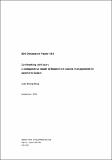| dc.contributor.author | Deng, Luka Biong | |
| dc.coverage.spatial | Sudan | en_GB |
| dc.date.accessioned | 2014-06-27T12:04:38Z | |
| dc.date.available | 2014-06-27T12:04:38Z | |
| dc.date.issued | 2002 | |
| dc.identifier.citation | Deng, L.B. (2002) Confronting civil war : a comparative study of household assets management in southern Sudan. Discussion paper series, 381. Brighton: IDS. | en_GB |
| dc.identifier.uri | https://opendocs.ids.ac.uk/opendocs/handle/20.500.12413/4101 | |
| dc.description.abstract | This paper examines the assets management strategies adopted by households exposed to prolonged civil war. The paper is based on fieldwork conducted in Bahr el Ghazal region, southern Sudan in 2000-1, which covered 563 sample households that were exposed during the 1990s to counterinsurgency warfare and drought. The paper reviews and critiques risk management aproaches in the context of civil war. It is argued that civil wars are caused by grievances and sustained by greed and economic agenda. In the context of Sudan the policies pursued by the ruling northern elite resulted in apparent regional socio-economic inequality with southern Sudan suffering most, which generated grievances and rebellion in the south. A distinction is made between exogenous and endogenous counterinsurgency warfare with endogenous counterinsurgency warfare having more profound effects on the rural livelihoods than other forms of conflict. The findings of the fieldwork support the hypothesis that communities exposed to the risk of civil war consciously take rational courses of action over their assets to confront the adverse effects of the war. The study found that non-poor households were, paradoxically, more susceptible to the risk of endogenous counterinsurgency warfare than poor households. Contrary to the prevalent view in the literature, the study found that diversification might not be the best risk management strategy for households exposed to the risk of counterinsurgency warfare, as some households tend to specialise. While endogenous counterinsurgency warfare tends to erode social capital, communities exposed to exogenous counterinsurgency tend to be more cohesive with strong community-based risk sharing arrangements. Also contrary to the prevailing assets-vulnerability argument, the study found a significant positive correlation between famine mortality and initial wealth, particularly among households exposed to the risk of endogenous counterinsurgency warfare. The study found the normal inverse correlation between famine mortality and wealth among households exposed to drought while households exposed to the risk of exogenous counterinsurgency warfare, paradoxically, did not experience any excess mortality during the famine of 1998. One apparent policy implication is that as communities exposed to civil war consciously manage their assets, it is possible to pursue poverty programmes during conflict in order to support the innovative household assets management strategies as well as addressing the underlying sources of grievance and horizontal inequality. While such programmes may not be relevant to communities exposed to endogenous counterinsurgency warfare, they are appropriate to support assets management strategies adopted by households exposed to exogenous counterinsurgency warfare. | en_GB |
| dc.language.iso | en | en_GB |
| dc.publisher | IDS | en_GB |
| dc.relation.ispartofseries | IDS discussion papers;381 | |
| dc.rights.uri | http://www.ids.ac.uk/files/dmfile/IDSOpenDocsStandardTermsOfUse.pdf | en_GB |
| dc.subject | Environment | en_GB |
| dc.subject | Health | en_GB |
| dc.subject | Politics and Power | en_GB |
| dc.subject | Poverty | en_GB |
| dc.subject | Security and Conflict | en_GB |
| dc.title | Confronting civil war : a comparative study of household assets management in southern Sudan | en_GB |
| dc.type | IDS Discussion Paper | en_GB |
| dc.rights.holder | Institute of Development Studies | en_GB |
| dc.identifier.koha | 134938 | |

